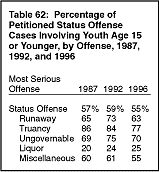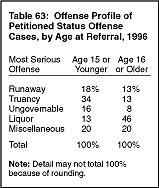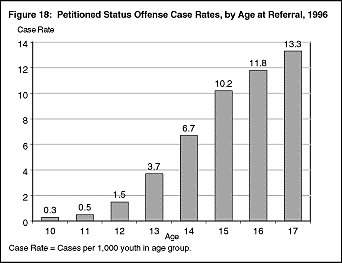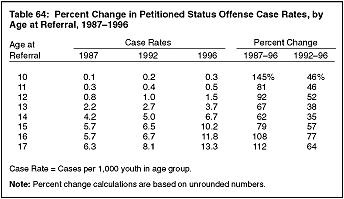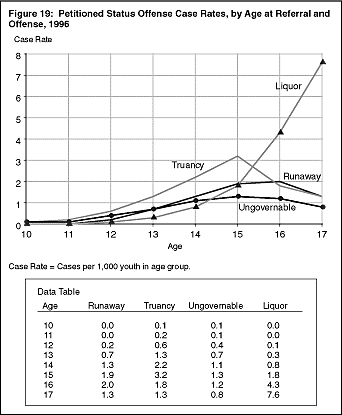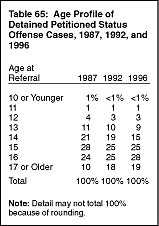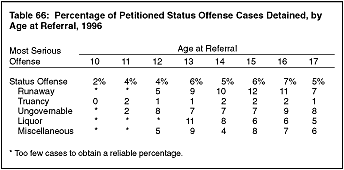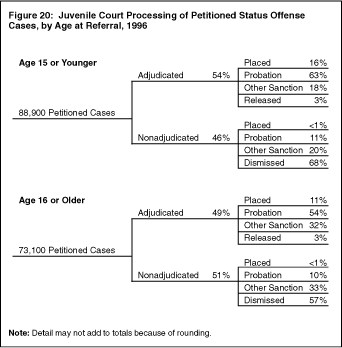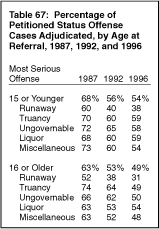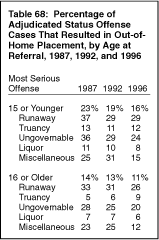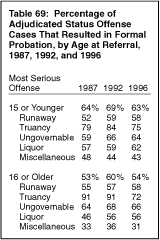|
Juveniles age 15 or younger at the time of court referral accounted for 55% of formally processed status offense cases disposed by courts in 1996, compared with 57% in 1987 (table 62). Juveniles age 15 or younger were involved in 77% of truancy cases, 70% of ungovernability cases, 63% of runaway cases, and 25% of status liquor law violation cases. The differing offense profiles of younger and older juveniles reflect age-related differences in behavior (table 63). Truancy was a more common charge among younger juveniles (34% of cases, compared with 13% for older juveniles); liquor law violations were more common among older juveniles (46% of cases, compared with 13% for younger juveniles).
Petitioned status offense case rates increased continuously with the age of juveniles (figure 18). In 1996, juvenile courts processed 3.7 petitioned status offense cases involving 13-year-old juveniles for every 1,000 13-year-olds in the juvenile population. The case rate for 15-year-olds (10.2) was more than double the rate for 13-year-olds, while the rate for 17-year-olds (13.3) was more than three times that for 13-year-olds. Between 1987 and 1996, petitioned status offense case rates increased in all age categories (table 64). The rates for 10-year-olds, 16-year-olds, and 17-year-olds had the largest increases: 145%, 108%, and 112%, respectively.
Age-specific case rate patterns differed among the individual offense categories (figure 19). Truancy and ungovernability case rates peaked at age 15 and runaway case rates peaked at age 16. In contrast, status liquor law violation case rates increased continuously with age: from 1.8 at age 15 to 7.6 at age 17.
Detention
Youth ages 15 and 16 each accounted for one quarter or more of the cases involving detention (table 65). In contrast, youth younger than 13 accounted for only 4% of all detained cases.
The likelihood of detention in formally processed status offense cases varied little across age groups (table 66). Overall, detention was used in 5% to 7% of petitioned status offense cases involving youth between ages 13 and 17.
Judicial Decision and Disposition
The overall probability of adjudication was greater for status offenders age 15 or younger than for those age 16 or older (54% versus 49%) in 1996 (figure 20). The likelihood of adjudication was higher for the younger group for each of the four major status offense categories (table 67).
Between 1987 and 1996, the likelihood of adjudication declined for status offense cases involving younger youth (from 68% to 54%) and older youth (from 63% to 49%). The likelihood of adjudication declined in all offense categories for both age groups.
Adjudicated status offense cases involving juveniles younger than 16 were more likely to result in out-of-home placement than were cases involving older youth (16% versus 11% in 1996) (table 68). For both age groups, the proportion of adjudicated cases resulting in out-of-home placement declined between 1987 and 1996.
Adjudicated status offense cases involving younger juveniles were more likely to result in formal probation than were cases involving older juveniles (63% versus 54% in 1996) (table 69). A larger proportion of the older group was ordered to pay fines or to enter a treatment or counseling program (32% versus 18%), possibly reflecting the greater involvement of older juveniles in status liquor law violation cases. For both age groups, the overall proportion of adjudicated cases that resulted in formal probation remained about the same between 1987 and 1996.
|
